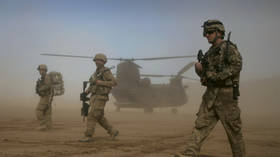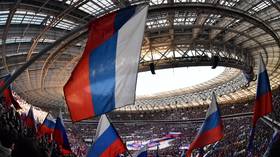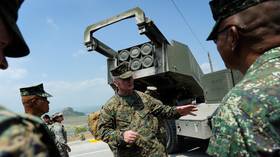Dmitri Trenin: Russia cannot afford to lose in Ukraine, but neither can the US – is there a non-nuclear way out of the deadlock?

The threat of the conflict in Ukraine getting out of control is not just an ever-present concern, but a reality.
The authors of the RAND Corporation’s recent paper, 'Pathways to Russian Escalation Against NATO From the Ukraine War', warn US policymakers to be careful in their statements and moves. This is particularly when deciding on military postures, deployment patterns, weapons capabilities, and the like, so that the steps taken by them do not provoke the Russian leadership into pre-emptive or retaliatory strikes, including using non-strategic nuclear weapons, or taking the campaign into NATO territory.
This is totally in line with America's overall approach of doing the maximum to weaken Russia on the battlefield in Ukraine while avoiding being drawn directly into a war against Moscow.
Seen from here, Washington is clearly escalating its participation in the conflict by constantly testing the limits of Russian tolerance of these moves. It started with the provision to Kiev of Javelin anti-tank systems; it was then amplified to include M777 howitzers and HIMARS MLRS systems; it is now moving in the direction of providing Ukraine with US-made military aircraft and training its pilots to fly them. In addition to the new packages of Western sanctions, Russia is also facing pressure on its geopolitically vulnerable outposts, whether regarding goods transit to and from its Kaliningrad exclave or the status of its forces in Transnistria, a small territory wedged between Ukraine and Moldova. Some refer to the latter as attempts by America's junior allies in Eastern Europe to open a second front against Russia.
So far, Russia’s actions and inaction have sometimes appeared surprising, even puzzling to US watchers. Moscow has refrained from strikes against transport links to Poland, cyberattacks against Ukrainian – not to mention US – critical infrastructure, or even destroying bridges across the Dnieper River. As for the most concerning step of all – Russia using tactical nuclear weapons – this scenario is irrelevant in a situation where hostilities are taking place on Ukrainian territory with Russian forces slowly but steadily advancing, and a “threat to the existence of the Russian Federation” – the doctrinal condition for such deployment – is out of the question.
Moscow's failure to respond immediately to high-profile Ukrainian actions, such as the constant shelling of the center of Donetsk; missile attacks against Russian villages and towns close to their shared border; or even the loss of the Moskva, the flagship of its Black Sea Fleet, hit and sunk by Ukraine with the material assistance of the United States, probably demonstrates the Kremlin’s unwillingness to be provoked by the enemy. President Vladimir Putin probably prefers his revenge to be served cold, and at the time of his choosing. It would be safe to say that nothing from this conflict will be forgotten by either side, but at least the Russians have refused to be distracted from their current central task – defeating the enemy's forces in Donbass and taking control over Ukraine’s east and south.
So far, US-led assistance to Kiev, whether military, financial or diplomatic, has not had a decisive impact on the battlefield. It has certainly propped up the Zelensky government and compensated for the Ukrainian forces’ losses of military equipment, thus contributing to the slowing down of Russian advances, but has not turned the tide of the war. One may conclude that the Kremlin sees no need, for now, to do things that would breach the resistance of the Biden Administration to domestic U.S. demands for a more rapid escalation of the US involvement in the conflict. Jake Sullivan’s recent comment to the Aspen Strategy Group, demonstrating the reluctance of the White House to provide ATACMS systems to Kiev, suggests that this approach has some value.
Looking ahead, one should expect more US escalation in any scenario of the evolution of fighting in Ukraine – whether Russia continues to gain ground (and integrate various new territories into the Russian Federation), or Ukraine mounts a counter-offensive (which so far it has failed to do). Russian officials express concern that a Ukrainian provocation presented as Moscow’s use of chemical weapons – which makes no military or any other sense but would certainly be believed in the US as a major egregious act by the Russians – could lead to Washington climbing abruptly up the escalation ladder.
Things may become even more serious, however, if the US or its NATO allies enter Ukraine, or otherwise become directly involved in the conflict; if the material assistance which they provide to Kiev starts making a major difference on the battlefield; or if those weapons are used to strike significant targets on Russia’s territory, such as the Crimean Bridge. There are parallel American concerns about Russia attacking transshipment points on NATO territory, launching significant counter-attacks against the United States or its allies, and using weapons of mass destruction. The last point has already been discussed, and as to the previous two, they could be in response to an adverse turn of events in the theater of operations.
Neither Russia nor the US can afford to lose in the conflict now raging in Ukraine. However, the difference between the situations faced by Washington and Moscow is huge. For the American leadership, a failure in Ukraine would be a strategic setback, politically costly both at home and internationally; for the Russian leadership, the outcome of its special military operation is an existential matter. In an asymmetrical conflict like this one, this amounts to an escalation advantage, if not dominance. What is vital for the two countries and the rest of the world is that this fight does not cross the nuclear threshold.















